Mee Rebus
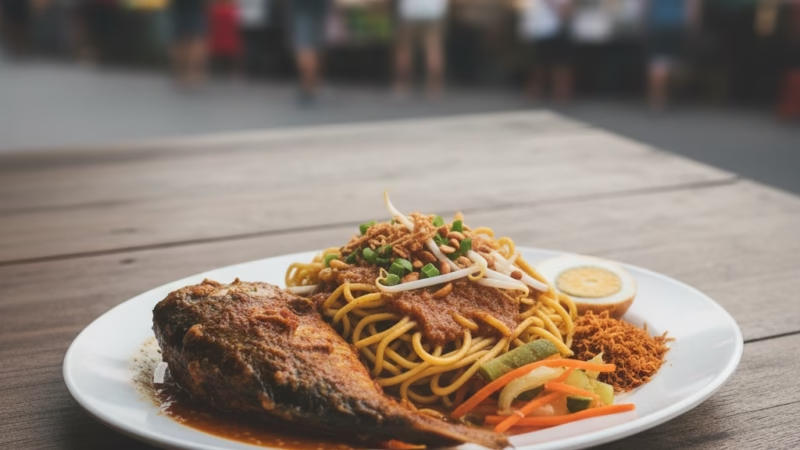
Malaysian Food
Mee Rebus – A Malaysian noodle dish served in a thick, savory gravy.
Origin
Malaysia, popular across Peninsular Malaysia and Singapore.
Category
Noodle dish / Main course / Street food.
Appearance
Yellow egg noodles served in a thick brownish-orange gravy, garnished with boiled eggs, fried shallots, green chilies, lime, and sometimes tofu or bean sprouts.
Ingredients
- Yellow egg noodles
- Sweet potato or yam (for gravy base)
- Dried shrimp or prawn paste
- Shallots and garlic
- Chilies
- Tamarind paste or lime juice
- Soy sauce
- Hard-boiled eggs
- Bean sprouts, tofu, fried shallots, and green chilies for garnish
Preparation
- Boil noodles until cooked.
- Prepare the gravy by blending sweet potato/yam with shrimp paste, garlic, shallots, chilies, and stock.
- Simmer the mixture until thickened.
- Pour gravy over noodles and add garnishes like boiled eggs, tofu, and lime.
Equipment
- Pot for boiling noodles
- Blender or food processor for gravy
- Wok or saucepan for cooking gravy
Variations
- Mee Rebus Johor – Slightly sweeter, sometimes includes beef stock.
- Mee Rebus Kedah – Uses thicker gravy with a richer shrimp flavor.
- Mee Rebus Singapore – Often lighter in texture and less spicy.
Taste
Savory, slightly sweet, tangy, and mildly spicy with umami notes from shrimp paste.
Texture
- Gravy: Thick, smooth, creamy
- Noodles: Soft yet springy
- Garnishes: Crunchy (fried shallots), soft (tofu/egg)
Aroma
Rich aroma of shrimp, garlic, and shallots with a hint of sweetness from sweet potato.
Sound
Gentle bubbling while cooking the gravy.
Cultural Significance
A beloved street food and comfort dish in Malaysia, often eaten for breakfast, lunch, or dinner.
Symbolism
Represents Malaysian multicultural culinary fusion—Malay, Chinese, and Indian influences.
Regional Cuisine
Common in Penang, Johor, Kedah, and Singapore, each with its distinct flavor profile.
Social Context
Sold at hawker stalls, restaurants, and night markets; often a communal dish enjoyed with family or friends.
Nutritional Information
- Rich in carbohydrates (from noodles and sweet potato)
- Moderate protein (from eggs and tofu)
- Low in fiber unless vegetables are added
Health Benefits
Provides energy, protein, and essential nutrients from eggs and legumes.
Dietary Restrictions
- Not suitable for vegans (contains egg and shrimp paste)
- Contains gluten (from egg noodles)
Allergens
Egg, shrimp, soy (if soy sauce used), gluten (from noodles)
Cost
Affordable street food, generally MYR 6–12 per serving in Malaysia.
Production
Can be prepared at home or commercially in hawker stalls and restaurants.
Sustainability
Depends on sourcing of shrimp/prawn paste and local vegetables. Homemade versions can be eco-friendly.
Availability
Widely available in Malaysia and Singapore, especially in Peninsular regions.
History
Originated from Malay cuisine; evolved with influences from Indian and Chinese cooking traditions.
Anecdotes
Often described as “Malaysian comfort food” due to its rich, flavorful gravy and hearty nature.
How to Prepare
- Boil noodles; drain and set aside.
- Blend sweet potato, shrimp paste, garlic, shallots, chilies, and stock into a smooth mixture.
- Cook mixture in a saucepan until thickened, adding seasonings.
- Pour over noodles and top with garnishes: hard-boiled eggs, tofu, fried shallots, lime, and green chilies.
FAQ
Q: Can I use instant noodles for Mee Rebus?
A: Traditional egg noodles are preferred, but instant noodles can be used for convenience.
Q: Is it spicy?
A: Typically mild to moderate, but can be adjusted with chilies.
Q: Can it be vegetarian?
A: Yes, by omitting shrimp paste and using vegetable stock.


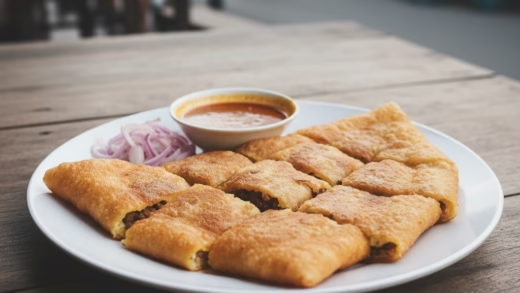





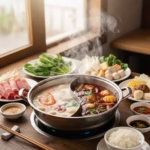
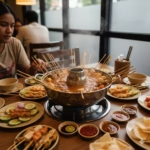
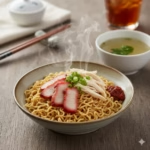

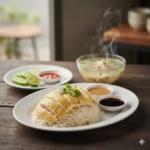


Comments are closed.